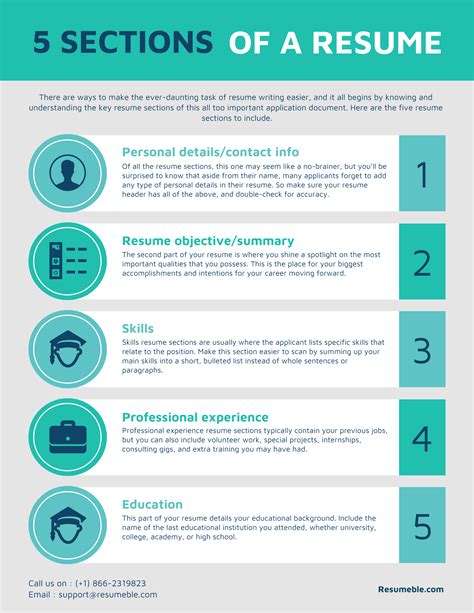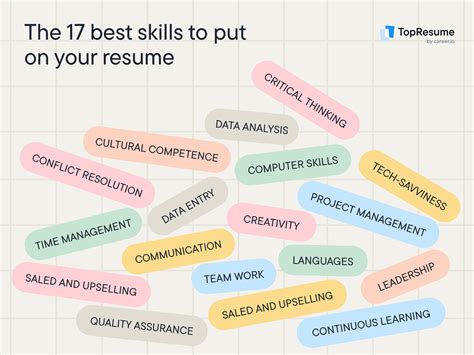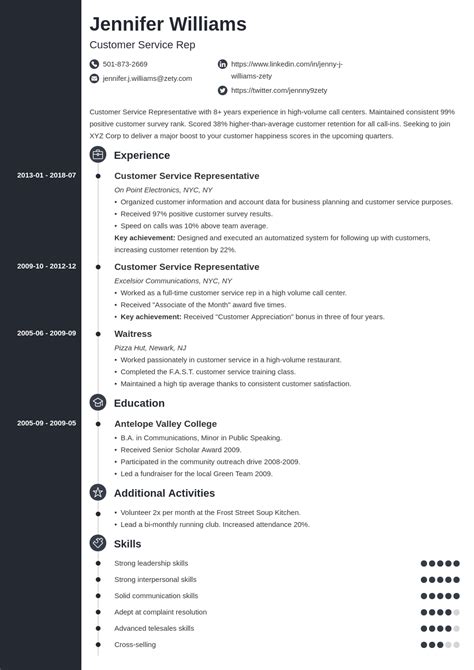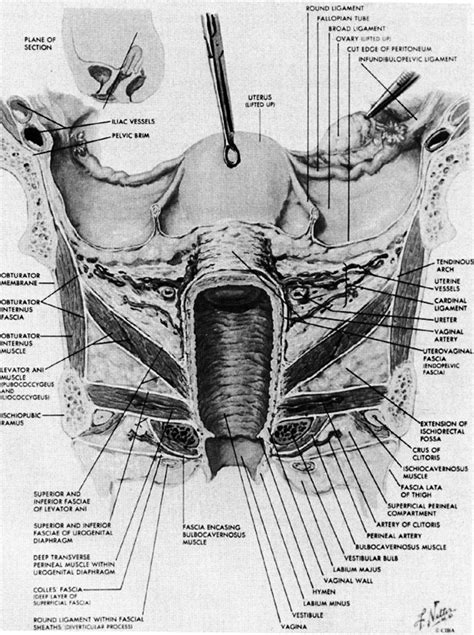What To Include On A Resume

Crafting an effective resume is an art, a strategic document that opens doors to opportunities and showcases your unique professional story. In today's competitive job market, a well-crafted resume is essential for making a strong first impression and increasing your chances of securing an interview. This comprehensive guide will delve into the critical elements that should be included on a resume, offering expert insights and practical tips to create a compelling resume that highlights your skills, experience, and value to potential employers.
The Foundation: Personal Information and Professional Overview

At the outset, your resume should provide a concise yet informative snapshot of your professional identity. Begin with your full name, ensuring it is easily identifiable and consistent across all your professional profiles and applications. Accompany this with your preferred contact details, including your email address, phone number, and a professional social media handle if relevant.
Below your contact details, provide a professional overview or summary statement. This section should encapsulate your career goals, key strengths, and the unique value you bring to the table. Tailor this overview to the specific role you're applying for, highlighting skills and experiences that align with the job requirements. Keep it concise, typically around 3-4 sentences, and use powerful adjectives to describe your expertise and impact.
Example Professional Overview:
“A seasoned marketing professional with a proven track record in developing innovative digital strategies, I excel at driving brand awareness and customer engagement. My expertise lies in crafting tailored marketing campaigns that deliver tangible results, having successfully increased brand visibility by 25% and boosted client retention rates by 15% in my previous roles.”
Education and Qualifications: A Solid Foundation

Your educational background forms the foundation of your professional journey. Include details of your highest educational qualification, such as a bachelor’s or master’s degree, specifying the institution, field of study, and the year of graduation. If you have achieved notable honors or distinctions during your academic journey, such as graduating with honors or winning academic awards, mention these to showcase your excellence and dedication.
For those with extensive work experience, the education section can be placed towards the end of the resume. However, for recent graduates or those seeking entry-level positions, highlighting your educational achievements is crucial and should be positioned more prominently.
Sample Education Section:
Education
Bachelor of Science in Computer Science, University of Technology, 2020 - 2024
Graduated with First Class Honors
Relevant Coursework: Artificial Intelligence, Machine Learning, Software Engineering
Professional Experience: Demonstrating Your Expertise
The heart of your resume lies in the professional experience section, where you showcase your skills, achievements, and the impact you’ve made in previous roles. Each position you’ve held should be listed with the job title, the company name, and the employment dates. Use bullet points to highlight your responsibilities and accomplishments, focusing on results and the value you brought to your previous employers.
Quantify your achievements whenever possible. For instance, instead of simply stating that you "increased social media engagement," provide a specific figure, such as "Increased social media engagement by 30% through strategic content planning and influencer partnerships."
Professional Experience Sample:
Digital Marketing Specialist, Tech Innovations Inc., 2021 - Present
- Developed and implemented a comprehensive digital marketing strategy, resulting in a 20% increase in website traffic and a 15% boost in online sales.
- Managed social media campaigns across multiple platforms, engaging with customers and driving brand awareness.
- Conducted market research and competitor analysis to inform marketing strategies and product development.
Skills and Certifications: Your Competitive Edge
Highlighting your skills and certifications is crucial to demonstrating your expertise and staying competitive in the job market. Divide this section into two parts: technical skills and soft skills. Technical skills might include proficiency in specific software, programming languages, or industry tools. Soft skills, on the other hand, encompass interpersonal abilities such as communication, leadership, teamwork, and problem-solving.
Consider including industry-specific certifications or professional development courses you've completed. These add credibility to your resume and showcase your commitment to staying updated with industry trends and best practices.
Skills and Certifications Section Example:
Technical Skills
- Proficient in Python, C++, and Java programming languages.
- Expertise in using Adobe Creative Suite, particularly Photoshop and Illustrator.
- Certified in Agile Project Management.
Soft Skills
- Exceptional communication and interpersonal skills, with a proven ability to collaborate effectively in diverse teams.
- Strong problem-solving and critical thinking abilities, adept at identifying and resolving complex issues.
- Skilled in conflict resolution and maintaining a positive work environment.
Additional Sections: Tailor Your Resume

Depending on your industry and career stage, you may choose to include additional sections to make your resume more comprehensive and tailored to your field. These could include:
- Publications: If you've authored or co-authored research papers, books, or articles, list them here, providing details such as the title, publication date, and the publisher or journal.
- Awards and Honors: Highlight any awards or accolades you've received, whether they are academic, professional, or community-based. This section can demonstrate your achievements and recognition in your field.
- Projects: For those with a portfolio of projects, especially in creative or technical fields, a dedicated section can showcase your work and provide links to your online portfolio or project repositories.
- Hobbies and Interests: While this section is optional, it can provide a more personal touch to your resume. Share hobbies or interests that are relevant to the job or demonstrate desirable traits, such as volunteer work or leadership in community organizations.
Final Tips and Best Practices
As you craft your resume, keep these best practices in mind:
- Tailor Your Resume: Customize your resume for each job application, highlighting the skills and experiences most relevant to the role.
- Use Action Verbs: Begin bullet points with strong action verbs to describe your responsibilities and achievements, such as "managed," "developed," or "implemented."
- Keep It Concise: Aim for a clear and concise resume, typically no longer than 2 pages for most professionals. Focus on the most relevant and impressive information.
- Proofread and Edit: Ensure your resume is free of grammatical errors and typos. Have a colleague or friend review it for a fresh perspective.
- Use a Professional Format: Choose a clean and easy-to-read resume format. Avoid fancy fonts or designs that might distract from your content.
Frequently Asked Questions
How long should a resume be?
+
A resume should typically be no longer than two pages for most professionals. However, this can vary depending on your industry and experience. For instance, academics or researchers may require a longer resume to showcase their extensive publications and projects. Always aim for brevity and conciseness, focusing on the most relevant and impressive information.
Should I include an objective statement on my resume?
+
Objective statements were more common in the past, but they have largely been replaced by professional summaries or overview statements. These summaries provide a concise snapshot of your career goals, key strengths, and the value you bring to the table. They are more effective at capturing the attention of recruiters and hiring managers, especially when tailored to the specific job you’re applying for.
How should I format my resume if I have gaps in my employment history?
+
Gaps in employment history can be a concern for recruiters. To address this, consider using a functional resume format, which focuses on your skills and achievements rather than a chronological list of jobs. Alternatively, you can explain the gaps briefly in your professional summary or cover letter, providing context such as personal projects, further education, or travel experiences that might have filled the gap.
Should I include references on my resume?
+
It’s generally recommended to avoid including references on your resume. Instead, you can indicate that references are available upon request. This saves space on your resume and allows you to provide a tailored list of references to the hiring manager once you’ve secured an interview. Ensure your references are aware that their contact information may be requested and that they are prepared to provide a positive reference for you.



